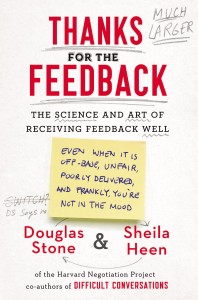 What are the goals of your feedback system and are you meeting them? According to Douglas Stone, co-author with Sheila Heen of “Thanks for the Feedback,” this is the first question companies should be asking themselves when it’s time to sit down for those annual reviews.
What are the goals of your feedback system and are you meeting them? According to Douglas Stone, co-author with Sheila Heen of “Thanks for the Feedback,” this is the first question companies should be asking themselves when it’s time to sit down for those annual reviews.
Feedback consists of two equally important elements—giving and receiving. Last month, I discussed some of the best practices with receiving feedback. This column will address giving it.
Stone contends that the success of delivering effective feedback, favorable or otherwise, has more to do with the receiver than the giver. As the example cited in last month’s column illustrated: The same feedback given simultaneously to two different people may result in widely divergent conclusions.
Stone and Heen point out some other considerations when giving feedback:
1. Giving feedback is most effectively delivered in a dialogue setting. The giver and receiver both learn and benefit from having a conversation. They will understand more about each other and the issues and more clearly view the issues being discussed. A conversation lays the groundwork for subsequent feedback, more open communication and better collaboration.
2. The giver should know whether the receiver has a “fixed” identity or a “growth” identity—that is, understanding if the receiver is simply a day-to-day work or a candidate for taking on additional responsibility with the company. If it’s the former, feedback might be seen as a verdict, or even worse, a life sentence. If the receiver has a “growth” identity, feedback is welcome information on what to work on next, how to improve and how to advance.
3. To maximize the opportunity for a successful feedback session, the giver should ask herself several important questions: Who has given you feedback well in the past? What made it effective? Was it what was said, how it was delivered, or a combination? The giver may then shape the feedback session around the answers to these questions.
4. Feedback givers should remember that negative feedback releases “triggers”— defensive responses we all have that get in the way of engaging productively in the feedback process. Stone identifies three:
- The “Truth” trigger: The feedback is wrong, inaccurate and baseless. “ You’re saying I’m unavailable? I’m at my desk 60 hours a week.”
- The “Relationship” trigger: The giver’s credibility, judgment or status is questionable, so the feedback lacks validity. “You may be right, but I won’t take this feedback from you!”
- The “Identity” trigger: Whether it’s right or wrong, true or baseless, critical feedback threatens the receiver’s sense of self. When we feel under attack, defense mechanisms kick in. A boss’ comment, “Make sure you’re on your game tomorrow” to someone who is hard-working and capable but insecure can raise fears of inadequacy, bring up past screw-ups and undermine self-confidence.
Fortunately for givers AND receivers of feedback (everyone), “Thanks for the Feedback” offers ways we can learn to put feedback in perspective, disentangle feedback from a relationship, dismantle distortions and process feedback productively.
